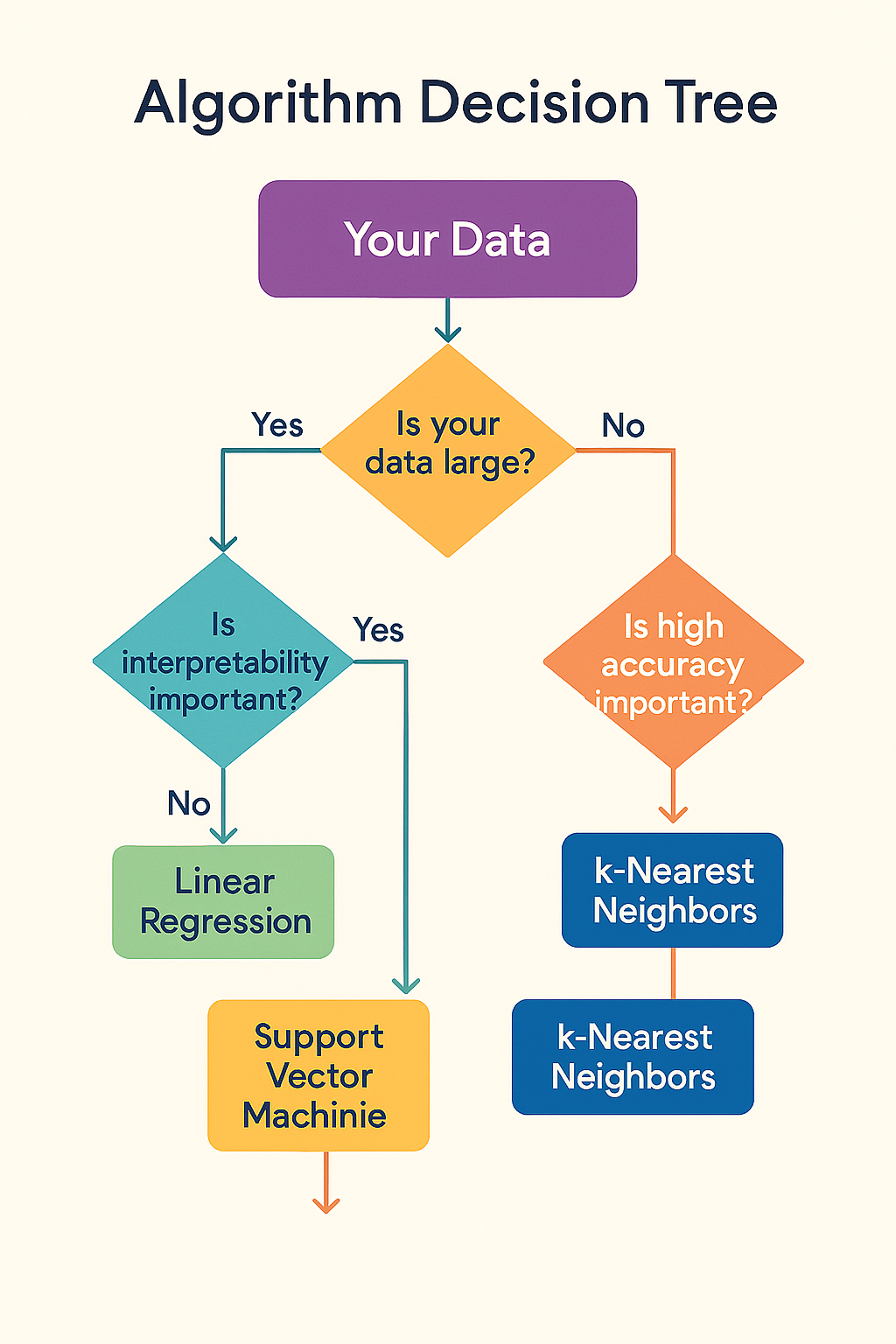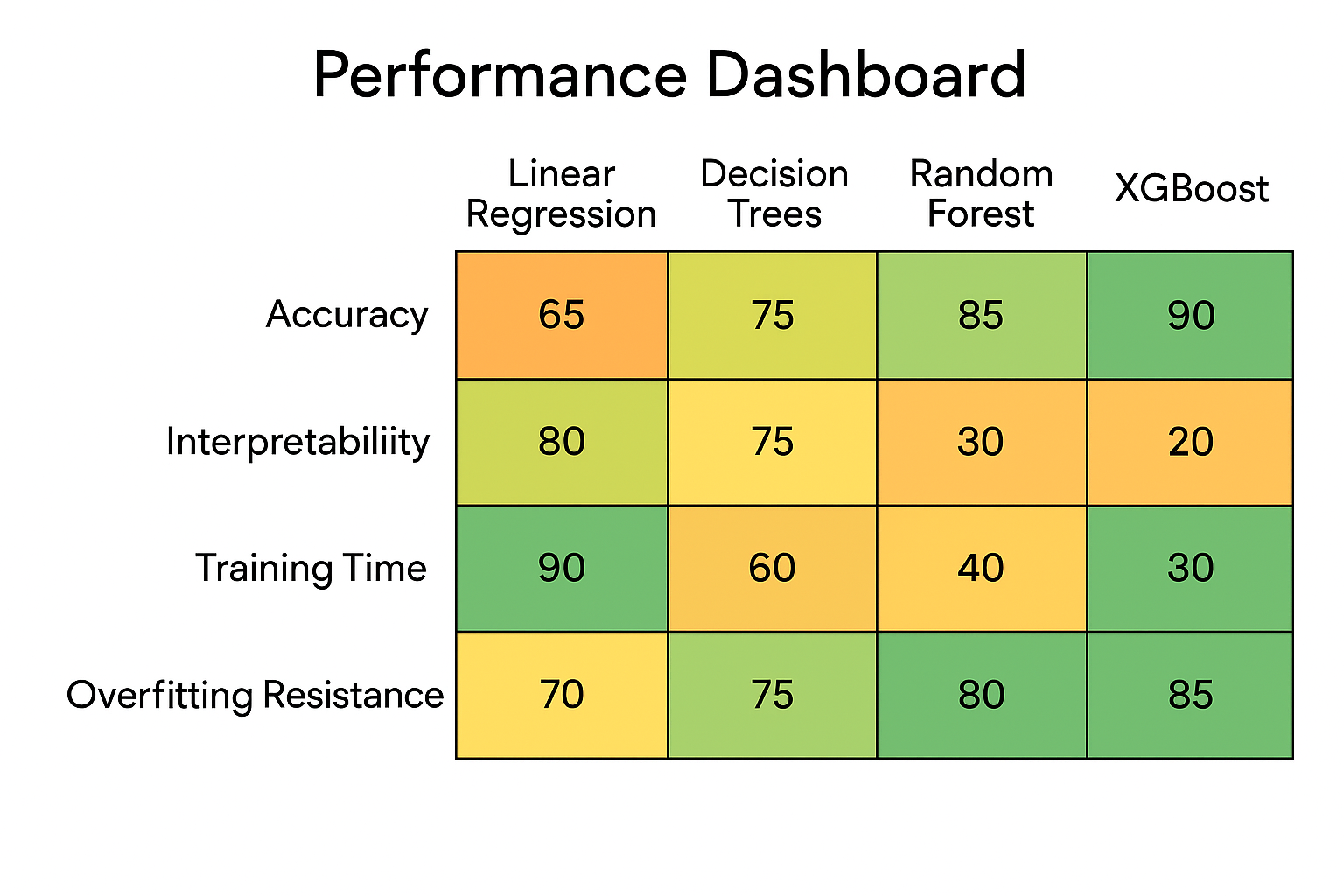The Journey We've Taken
Throughout this tutorial, we've explored the relationships between different ML techniques. Now let's put it all together with a practical framework for choosing the right algorithm.
Interactive Algorithm Selection Tree
Answer questions about your problem to get personalized algorithm recommendations:
Start Here: What type of data do you have?
Key Decision Factors
📊 Data Type & Size
- Tabular data: Tree-based methods excel
- Large datasets: Consider scalability
- Small datasets: Avoid complex models
- Missing values: XGBoost handles automatically
🎯 Problem Requirements
- Accuracy priority: XGBoost or Gradient Boosting
- Interpretability: Decision Trees or Linear models
- Speed: Random Forest for balance
- Stability: Random Forest for robustness
⚡ Resource Constraints
- Limited time: Random Forest (less tuning)
- Limited compute: Linear models
- Memory constraints: Avoid deep ensembles
- Real-time inference: Consider model size
🔧 Maintenance & Deployment
- Production stability: Well-tested algorithms
- Model updates: Consider retraining cost
- Monitoring: Feature importance tracking
- Scalability: Cloud-native solutions
Real-World Case Studies
Explore how different algorithms solve real business problems:
🎯 Interactive Case Studies
Click on a case study to see the algorithm selection process in action:
💳 Credit Risk Assessment
Problem: Bank needs to predict loan defaults with 95%+ accuracy
Data: 50K customers, mixed numerical/categorical features
Solution: XGBoost
✓ Handles mixed data types
✓ High accuracy requirement
✓ Feature importance for regulations
✓ Missing value handling
🏥 Medical Diagnosis
Problem: Diagnose disease from patient symptoms with explainable results
Data: 5K patients, interpretability critical
Solution: Decision Tree + Random Forest Ensemble
✓ Interpretable decision rules
✓ Small dataset size
✓ Feature importance clear
✓ Medical professionals can understand
🚀 Startup Customer Prediction
Problem: Limited data, need quick results, tight budget
Data: 2K customers, fast iteration needed
Solution: Random Forest
✓ Works well with small data
✓ Minimal hyperparameter tuning
✓ Quick to implement and iterate
✓ Robust against overfitting
📡 IoT Sensor Monitoring
Problem: Real-time anomaly detection, resource constraints
Data: Streaming data, edge computing limitations
Solution: Regularized Linear Model
✓ Fast inference required
✓ Limited computational resources
✓ Streaming data compatibility
✓ Low memory footprint
Implementation Guide
Step-by-step guide to implementing your chosen algorithm in production:
From Prototype to Production
1
Data Preparation
- Clean and validate data
- Handle missing values
- Feature engineering
- Train/validation/test split
2
Algorithm Selection
- Use decision tree framework
- Consider constraints
- Baseline with simple model
- Test multiple candidates
3
Hyperparameter Tuning
- Cross-validation setup
- Grid/random search
- Bayesian optimization
- Early stopping
4
Model Validation
- Multiple metrics evaluation
- Cross-validation
- Out-of-time testing
- Feature importance analysis
Chapter 8: Final Mastery Quiz
Test your complete understanding of ML model relationships and selection:
Question 1: Algorithm Selection for Production System
You have a tabular dataset with 100K rows, mixed data types, and need maximum accuracy for a production system. Which algorithm should you choose?
Linear Regression - too simple for complex patterns
Decision Tree - likely to overfit without ensembling
Random Forest - good but XGBoost typically achieves higher accuracy
XGBoost - optimal for large tabular data with mixed types and accuracy requirements
Correct! XGBoost is ideal for this scenario: it excels on tabular data, handles mixed data types automatically, includes built-in regularization, and typically achieves the highest accuracy on structured data problems.
Question 2: Medical Diagnosis System Requirements
For a medical diagnosis system where doctors need to understand the decision process, which approach is most appropriate?
XGBoost with default settings
Decision Tree or shallow Random Forest - with feature importance analysis
Deep Gradient Boosting with 1000+ trees
Highly regularized linear model only
Exactly! Medical applications require interpretability. Decision Trees provide clear decision paths, and shallow Random Forests offer both interpretability and improved robustness while maintaining explainable feature importance.
Question 3: Random Forest vs Gradient Boosting Trade-off
What is the most important factor when choosing between Random Forest and Gradient Boosting?
Random Forest is always better for large datasets
Trade-off between accuracy needs and overfitting risk/tuning complexity
Gradient Boosting is always more accurate
Random Forest only works with numerical data
Perfect! The key trade-off is accuracy vs complexity: Gradient Boosting can achieve higher accuracy but requires more careful tuning and has higher overfitting risk. Random Forest is more robust and stable with minimal tuning.
Question 4: Evolution of Ensemble Methods
Which sequence best represents the evolution from simple to advanced ensemble methods?
Linear Models → Decision Trees → Random Forest → Gradient Boosting → XGBoost
Decision Trees → Linear Models → XGBoost → Random Forest
XGBoost → Gradient Boosting → Random Forest → Decision Trees
Random Forest → Decision Trees → Linear Models → XGBoost
Excellent! This sequence shows the natural progression: starting with simple linear models, moving to single decision trees, then parallel ensembles (Random Forest), sequential ensembles (Gradient Boosting), and finally optimized implementations (XGBoost).
Question 5: Bias-Variance Trade-off Understanding
Which statement best describes the bias-variance trade-off in the algorithms we studied?
All algorithms have the same bias-variance characteristics
Linear models have high bias/low variance, decision trees have low bias/high variance
Ensemble methods always increase both bias and variance
XGBoost eliminates the bias-variance trade-off completely
Correct! Linear models are consistent but potentially too simple (high bias, low variance), while decision trees are flexible but unstable (low bias, high variance). Ensemble methods help balance this trade-off.
Question 6: Regularization Purpose
What is the primary purpose of L1 and L2 regularization in machine learning?
To make models train faster
To prevent overfitting by penalizing model complexity
To increase model accuracy on training data
To make models more interpretable
Right! Regularization techniques like L1 (Lasso) and L2 (Ridge) add penalties to the loss function to prevent the model from becoming too complex and overfitting to the training data.
Question 7: Ensemble Method Advantages
Why do ensemble methods typically outperform single models?
They always use more data
They are faster to train
They combine multiple perspectives to reduce individual model weaknesses
They require less hyperparameter tuning
Exactly! Ensemble methods work by combining multiple models that may make different errors, thereby reducing the impact of individual model weaknesses and improving overall performance.
Question 8: Random Forest Key Features
What are the two key techniques that make Random Forest effective?
Gradient descent and regularization
Bootstrap sampling and feature randomness
Sequential training and residual learning
L1 and L2 regularization
Perfect! Random Forest uses bootstrap sampling to create diverse datasets for each tree and feature randomness to ensure trees make different splits, reducing correlation between trees.
Question 9: Gradient Boosting Learning Process
How does gradient boosting differ from random forest in its learning approach?
It uses deeper trees
It trains models sequentially, each learning from previous errors
It uses more data
It requires more computational power
Correct! Gradient boosting trains models sequentially, with each new model specifically trained to correct the residual errors of the previous models, while Random Forest trains trees independently in parallel.
Question 10: When to Use Linear Models
In which scenario would you choose a linear model over ensemble methods?
When you need maximum accuracy
When you have very large datasets
When you need fast inference and interpretability with limited computational resources
When your data has many missing values
Excellent! Linear models are ideal when you need fast inference and interpretability with limited computational resources. They train quickly, make predictions instantly, and provide clear coefficient interpretations.
Question 11: XGBoost Competitive Advantages
What makes XGBoost superior to traditional gradient boosting?
It uses different algorithms
System optimizations, built-in regularization, and automatic missing value handling
It only works with large datasets
It doesn't require hyperparameter tuning
Right! XGBoost improves upon gradient boosting with parallel processing, cache optimization, built-in L1/L2 regularization, automatic missing value handling, and advanced tree pruning techniques.
Question 12: Feature Importance Analysis
Why is feature importance analysis crucial in ensemble methods?
It makes models train faster
It reduces overfitting automatically
It helps understand model behavior and identify the most influential variables
It eliminates the need for data preprocessing
Perfect! Feature importance helps understand which variables drive model predictions, enables feature selection, supports model interpretation, and can reveal insights about the underlying problem domain.
Question 13: Cross-Validation Purpose
What is the primary benefit of using cross-validation in model selection?
It makes models more accurate
It provides more reliable estimates of model performance on unseen data
It reduces training time
It eliminates the need for a test set
Exactly! Cross-validation uses multiple train/validation splits to get a more robust estimate of how the model will perform on unseen data, reducing the impact of any single validation set's characteristics.
Question 14: Hyperparameter Tuning Strategy
What is the recommended approach for hyperparameter tuning?
Always use random search
Tune all parameters simultaneously from the start
Start with default parameters, then systematic tuning (grid search, then random search)
Only tune learning rate
Correct! Best practice is to establish a baseline with default parameters, then systematically tune parameters starting with the most impactful ones, using grid search for few parameters and random search for many parameters.
Question 15: Production Deployment Considerations
What is the most critical factor when deploying ML models to production?
Using the most complex model possible
Achieving 100% accuracy on training data
Monitoring model performance and data drift over time
Never updating the model once deployed
Excellent! Production models need continuous monitoring for performance degradation, data drift, and changing patterns. Without monitoring and updating, even the best models will deteriorate over time as real-world conditions change.

